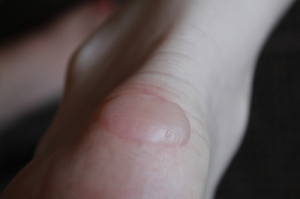Blisters Prevention and Treatment
Blisters bring in the heat. A small blister can’t kill you but it really hurts a lot. Blisters happen when your shoe or your socks rub against your skin and causes friction. As a response to the friction, the body produces fluids beneath the skin where the rubbing occurs. This fluid builds up causing pressure and pain. Mind your sweaty feet!
While blisters are not really life threatening, it poses a risk of infection which could heal for a few days or weeks. This could easily sideline any runner or athlete.
Blister Prevention for Runners
Preventing blisters is actually quite easy. So easy in fact that it could be easily overlooked. So mind these prevention tips and always keep these in mind.
Mind your socks. Wear socks that are blister-free. You can also try to double up your socks so the friction will not occur between skin and socks rather it will happen between the two socks.
Moisten your blister prone parts. Friction occurs when your skin is dry. Sweating may moisten it for only so long. What better way to reduce friction than to apply creams and lotions that would moisten your skin and reduce the effects of friction. Applying lubricants can also help including Vaseline.
Wear comfortable kicks. Yeah, your shoes are stylish but can your feet breathe in it? Wear comfortable shoes with a space between your toes and the end of the toe box. Also try to factor in the socks that you will be wearing with those shoes. Your socks might be too thick and squeeze the feet and promote friction.
Hydrate yourself. Aside from applying anything to your feet, it also helps to hydrate your body. Make sure you take in enough water. Enough means not too much which can cause excess fluids to build up on your feet or too little which basically does the same. Maintaining the balance is important.
Tape it. You can put a zinc-oxide tape or anything similar to your foot where potential blisters could occur. This includes the heel and your toes. Other athletes prefer to place the tape on the shoes instead of on their bodies. This could help as well.
Blister Treatment for Runners
Most blisters heal naturally. However, there are instances when proper management and care is needed. Here are some steps to manage and treat blisters.
Popping Blisters. When treating or curing blisters. the big question that usually arises is “Should you pop it?”This could lead to a debate of epic proportions. However, most physicians would recommend NOT popping the blisters as much as possible to avoid infection. Should you feel the urge or the need to pop it, make sure your hands and surroundings are clean and sterile. Use a needle with alcohol to puncture the blister and drain it slowly. Prepare yourself for a big mess if it is a blood blister or better yet, don’t pop the blood blister just yet.
Dress it. Whether you’ve popped it or not, the best approach is to place a sterile dressing over the blister and let it heal on its own. Make sure that your dressing is tight to prevent bacterial infection. The dressing will also help if the blister popped suddenly. The released liquid will not be messy and there’s a lesser risk for infection.
Dip it in. You can remove your dressed up blister periodically and dip it in Epsom salts. Just follow the instructions on the Epsom salts. This will draw out the remaining fluid. Change the bandage after soaking.
Ice it. Applying ice on the blister and its surrounding area could prevent swelling and pain especially in cases that it is a blood blister. Make sure though that the ice does not touch your skin. Place a towel around it before applying.
Have you ever had a serious case of blisters? Share it with us.
More about Running Injuries:
- Side Stitch
- Blisters
- Achilles Tendonitis
- Iliotibial Band Syndrome (ITBS)
- Plantar Fasciitis
- Runner’s Knee
- Shin Splits
